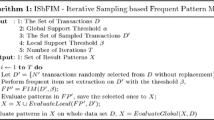Abstract
Protein kinases, a family of enzymes, have been viewed as an important signaling intermediary by living organisms for regulating critical biological processes such as memory, hormone response and cell growth. The unbalanced kinases are known to cause cancer and other diseases. With the increasing efforts to collect, store and disseminate information about the entire kinase family, it not only leads to valuable data set to understand cell regulation but also poses a big challenge to extract valuable knowledge about metabolic pathway from the data. Data mining techniques that have been widely used to find frequent patterns in large datasets can be extended and adapted to kinase data as well. This paper proposes a framework for mining frequent itemsets from the collected kinase dataset. An experiment using AMPK regulation data demonstrates that our approaches are useful and efficient in analyzing kinase regulation data.
Access this chapter
Tax calculation will be finalised at checkout
Purchases are for personal use only
Preview
Unable to display preview. Download preview PDF.
Similar content being viewed by others
References
Hieter, P., Boguski, M.: Functional Genomics: It’s All How You Read It the entire genome sequence. SCIENCE 278(24), 601–602 (1997)
Hunter, L.: Artificial Intelligence and Molecular Biology. AAAI, Menlo Park (1993)
Musi, N., Fujii, N., Hirshman, M.F., Ekberg, I., Froberg, S., Ljungqvist, O., Thorell, A., Goodyear, L.J.: AMP-activated Protein Kinase (AMPK) Is Activated in Muscle of Subjects with Type 2 Diabetes During Exercise. Diabetes 50, 921–927 (2001)
Beg, Z.H., Allmann, D.W., Gibson, D.M.: Modulation of 3-hydroxy-3-methylglutaryl Coenzyme: A Reductase Activity with cAMPand with protein fractions of rat liver cytosol. Biochem Biophys Res Commun. 54, 1362–1369 (1973)
Carlson, D., Fryer, L.G., Woods, A.: Regulation of Hepatic Acetyl Coenzyme A Carboxylase by Phosphorylation and Dephosphorylation. Journal of Bio. Chem. 248, 378–380 (1973)
Fischer, R.S., Quinlan, M.P.: While E1A can facilitate epithelial cell transformation by several dominant oncogenes, the C-terminus seems only to regulate rac and cdc42 function, but in both epithelial and fibroblastic cells. Virology 269(2), 404–419 (2000)
Zhang, C., Zhang, S.: Association Rule Mining: Models and Algorithms. In: Zhang, C., Zhang, S. (eds.) Association Rule Mining. LNCS (LNAI), vol. 2307, Springer, Heidelberg (2002)
Han, J., Pei, J., Yin, Y.: Mining frequent patterns without candidate generation. In: Proceedings of the ACM SIGMOD International Conference on Management of Data, pp. 1–12 (2000)
Doddi, S., Marathe, A., Ravi, S.S., Torney, D.C.: Discovery of Association Rules in Medical Data. Med. Inform. Internet. Med. 26, 25–33 (2001)
Stilou, S., Bamidis, P.D., Maglaveras, N., Pappas, C.: Mining Association Rules from Clinical Databases: An Intelligent Diagnostic Process in Healthcare. Medinfo. 10, 1399–1403 (2001)
Sakamoto, K., McCarthy, A., Smith, D., Green, K.A., Hardie, D.G., Ashworth, A., Alessi, D.R.: Deficiency of LKB1 in skeletal muscle prevents AMPK activation and glucose uptake during contraction. The EMBO Journal 24, 1810–1820 (2005)
Durante, P.E., Mustard, K.J., Park, S.H., Winder, W.W., Hardie, D.G.: Effects of Endurance Training on Activity and Expression of AMP-activated Protein Kinase Isoforms in Rat Muscles. Am. J. Physiol. Endocrinol Metab. 283, 178–186
Agrawal, R., Imielinshki, T., Swami, A.: Mining Association Rules between Sets of Items in Large Databases. In: Proceeding of ACM-SIGMOD International Conference on Management of Data, pp. 207–216 (1993)
Author information
Authors and Affiliations
Editor information
Editors and Affiliations
Rights and permissions
Copyright information
© 2006 Springer-Verlag Berlin Heidelberg
About this paper
Cite this paper
Chen, Q., Chen, YP.P., Zhang, C., Li, L. (2006). Mining Frequent Itemsets for Protein Kinase Regulation. In: Yang, Q., Webb, G. (eds) PRICAI 2006: Trends in Artificial Intelligence. PRICAI 2006. Lecture Notes in Computer Science(), vol 4099. Springer, Berlin, Heidelberg. https://doi.org/10.1007/978-3-540-36668-3_25
Download citation
DOI: https://doi.org/10.1007/978-3-540-36668-3_25
Publisher Name: Springer, Berlin, Heidelberg
Print ISBN: 978-3-540-36667-6
Online ISBN: 978-3-540-36668-3
eBook Packages: Computer ScienceComputer Science (R0)




